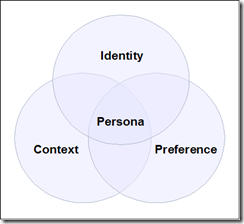Identity Trend 8: Personalization and Context
This post is the eighth in a series of eleven posts I am writing about key trends in the Identity Management industry.
Much of the work I have been doing with Sun Microsystems during the past year has been focused on how to leverage Identity to enhance personalization of user experience across multiple “screens of your life.†Project Destination, a Sun initiative which I lead, is all about enhancing online user experience through “Identity-enabled Service Orchestration and Delivery.â€
Personalization increases the value of online user experience by presenting relevant content to a specific user at a particular time and tailoring the user experience to fit what a user is doing at that time. An effective combination of Identity and Context is essential for personalization.
Context refers to the idea that computer systems and networks can both sense and react based on their environment. For example, devices may have information about the circumstances under which they are able to operate and based on rules, or an intelligent stimulus, react accordingly. Context is not simply a state, but part of a process in which users are intimately involved and user interfaces are adapted in real time to accommodate changes in user or system context. For example, a context aware mobile phone may know that it is currently in the meeting room, and that the user has sat down. The phone may conclude that the user is currently in a meeting and reject any unimportant calls. Context-aware systems are concerned with the acquisition of context, the abstraction and understanding of context, and application behavior based on the recognized context. Context awareness is regarded as an enabling technology for ubiquitous computing systems. The Wikipedia article, “Context Awareness,†provides more details and valuable links to material on the subject.
The emergence of Context as a key component of personalization will likely accelerate as service providers seek to answer demand for the delivery of identity-enabled, highly personalized, blended services to subscribers of modern networks.
 Combining a third element, “Preference,†will enable further personalization. In a blog post entitled, “Identity, Context, Preference and Persona,†I proposed that the concept of persona is best understood as the intersection of three elements:
Combining a third element, “Preference,†will enable further personalization. In a blog post entitled, “Identity, Context, Preference and Persona,†I proposed that the concept of persona is best understood as the intersection of three elements:
Persona is not just a partial projection of one’s identity. It must take into account the context in which a person exists at the moment, and the preferences the person makes relative to that particular situation. Personalization of a product or service must be synchronized with the persona of a person at any relevant point in time – his or her current persona.
I expect that two key context-enabled concepts will continue to gain more focus in the near future:
- Selective Personae refers to the ability of a person to choose which persona he or she desires to use in a particular context to enable certain types of online experiences. For example, online systems (such as BigDialog, a project directed by eCitizen Foundation and Massachusetts Institute of Technology) are emerging to enable citizens to interact more effectively with government officials. In such a case, a context-driven, selective persona system may validate that a user is indeed a citizen, but allow the user to specify how much personal information (e.g. age, marital status, race) he or she wishes to expose for a particular conversation.
- Purpose-driven Web refers to providing a context-driven online experience focused on what a person is doing or wants to do at a particular time, not just what sites the person may be visiting on line. For example, at the recent DIDW conference, Phil Windley, founder of of Kynetx proposed to enable contextualized, purpose-based user experiences using the web browser as a point of integration.
Recommendations:
Consider questions such as these to determine how your organization can leverage Context to enhance user experience:
- How can a more personalized user experience strengthen the relationship between my customers and my organization?
- What new business opportunities can we leverage if we can deliver better user experience to our users?
- In what different contexts (e.g. in-store, via web browser, with mobile phone, via TV, at home, at work, during travel) do my user interact with my organization?
- How can we augment Identity information we have about users with contextual information to further personalize user experience?
- How can information I have collected about user interactions with my organization be leveraged to further personalize a user experience?
- What privacy and security regulations limit how we can leverage user information?
- Can we effectively leverage user opt-in or opt-out techniques to meet individual user preferences?
- How can we leverage new context-driven concepts such as Selective Personae or Purpose-driven Web to personalize the user experience for our customers?
